

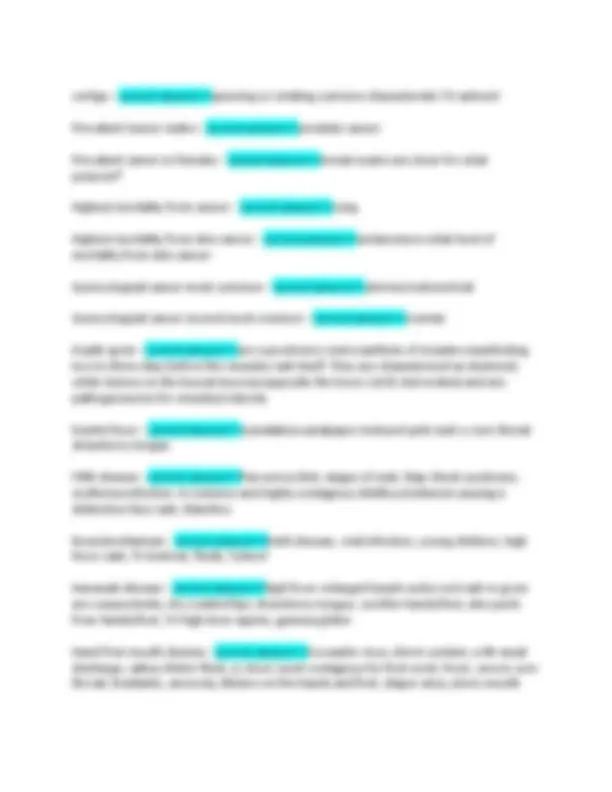
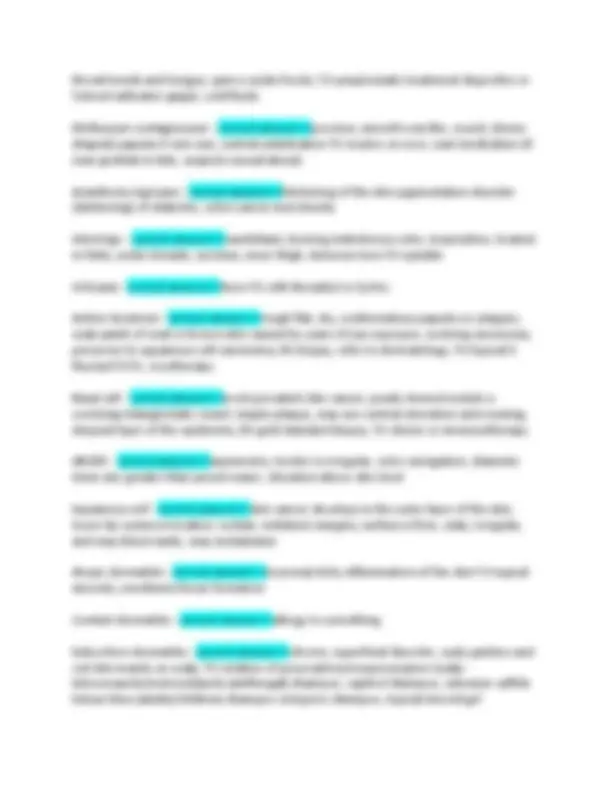


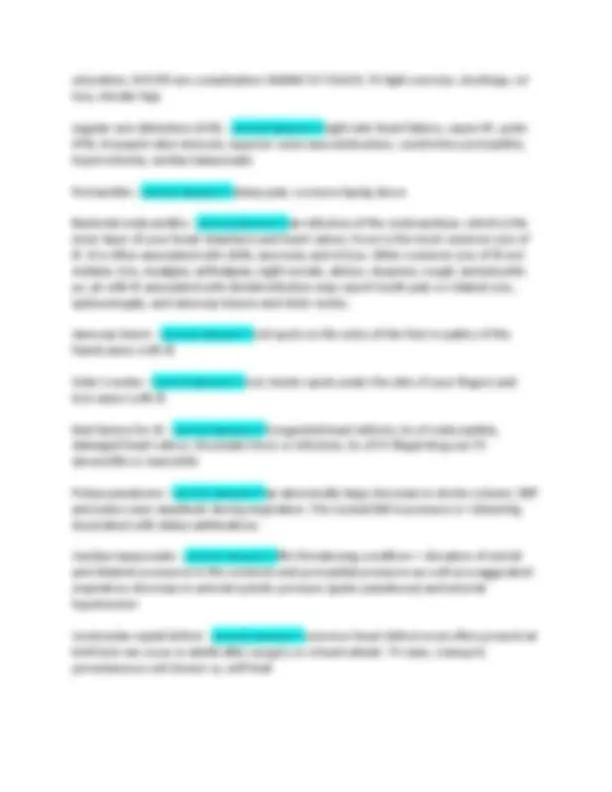

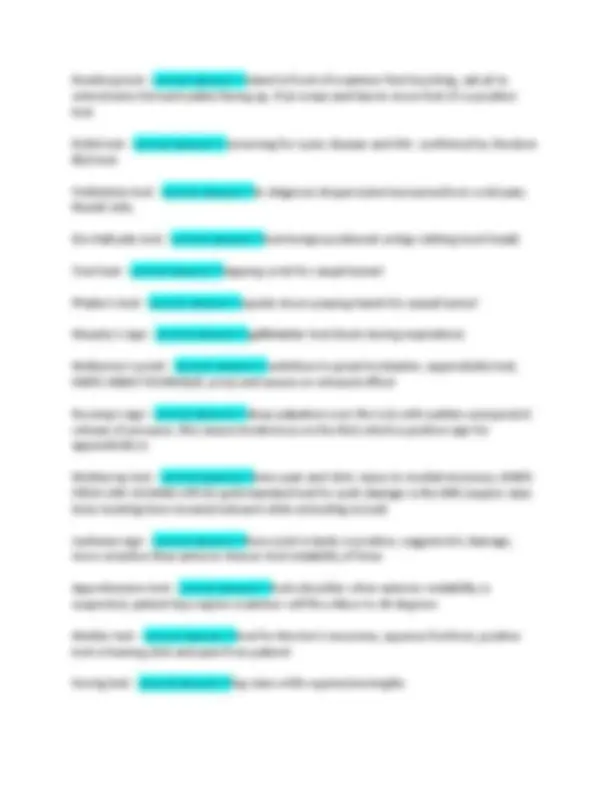



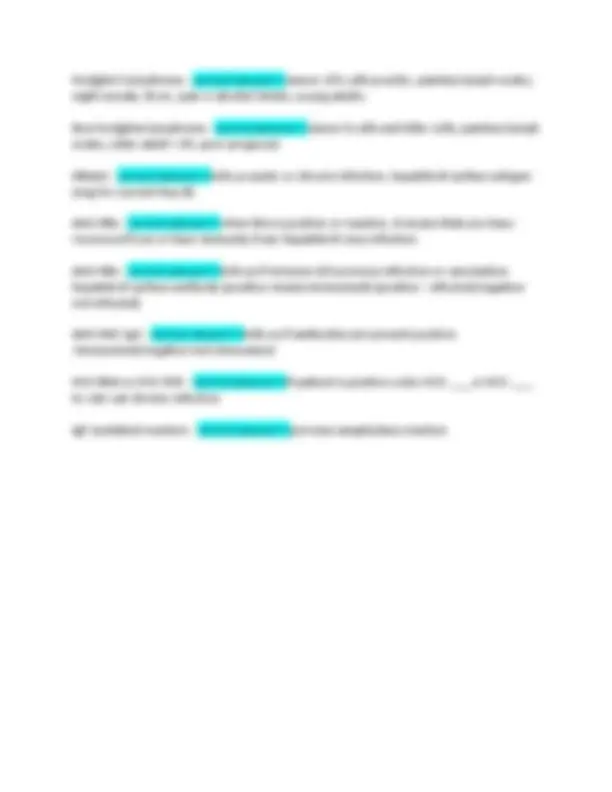


Study with the several resources on Docsity

Earn points by helping other students or get them with a premium plan


Prepare for your exams
Study with the several resources on Docsity

Earn points to download
Earn points by helping other students or get them with a premium plan
Community
Ask the community for help and clear up your study doubts
Discover the best universities in your country according to Docsity users
Free resources
Download our free guides on studying techniques, anxiety management strategies, and thesis advice from Docsity tutors
Allergies to PCN - correct answer>>use macrolides, fluoroquinolones to tx when allergies to ? Blepharitis - correct answer>>inflammation of eyelides, TX baby shampoo, warm compresses Sialolithiasis - correct answer>>stones w/i the salivary glands or the salivary gland ducts. Painful lump on jaw that comes and goes. ___ typically present pain and swelling in the involved gland, these symptoms are usually aggravated by eating or by anticipation of eating. Otitis media - correct answer>>inflammation of middle ear/inner, erythema, decreased tympanic membrane mobility, distorted landmarks, displaced light reflex, moderate to severe bulging, mastoid pain DX penumatic otoscopy TX analgesics Acetaminophen, ibuprofen, narcotic w codeine, amoxicillin, Augument, omnicef, ceftin, otic drops ciprofloxacin w dexamethasone. Otitis externa - correct answer>>swimmers ear, P. aeruginosa, external canal producing
Typology: Exams
1 / 20

This page cannot be seen from the preview
Don't miss anything!













Allergies to PCN - correct answer>>use macrolides, fluoroquinolones to tx when allergies to? Blepharitis - correct answer>>inflammation of eyelides, TX baby shampoo, warm compresses Sialolithiasis - correct answer>>stones w/i the salivary glands or the salivary gland ducts. Painful lump on jaw that comes and goes. ___ typically present pain and swelling in the involved gland, these symptoms are usually aggravated by eating or by anticipation of eating. Otitis media - correct answer>>inflammation of middle ear/inner, erythema, decreased tympanic membrane mobility, distorted landmarks, displaced light reflex, moderate to severe bulging, mastoid pain DX penumatic otoscopy TX analgesics Acetaminophen, ibuprofen, narcotic w codeine, amoxicillin, Augument, omnicef, ceftin, otic drops ciprofloxacin w dexamethasone. Otitis externa - correct answer>>swimmers ear, P. aeruginosa, external canal producing inflammation, itching, px, tragal/pinna px, otorrhea, DX culture, TX fluoroquinolone and polymyxin B cortisporin drops! Sensorineural loss - correct answer>>Weber test (top of head) no lateralization, normal finding, does not lateralize to either ear, bilateral hearing loss, if hear better in left ear, right _______ hearing loss. Conductive loss - correct answer>>Rinne test (behind pinna) - normal finding if AC last longer than BC bone conduction, good ear=air conduction > bone conduction, bad ear BC>AC. Sjorgen's syndrome - correct answer>>chronic autoimmune disorder characterized by decrease function of lacrimal and salivary glands Bacterial conjunctivitis - correct answer>>purulent (pus) exudate, initially unilateral, then often bilateral, self-limiting 5-7 days, delay treatment till 3rd day, TX eye drops or ointment polytrim, trimethoprim, polymyxin, macrolide
viral conjunctivitis - correct answer>>profuse tearing, mucus discharge, burning, concurrent URI, enlarged preauricular node, TX antihistamine, decongestant drops, Trifluridine in herpes conjunctivitis. Nystagmus - correct answer>>eye makes repetitive uncontrolled movements, decrease vision, depth perception, balance Fluorescein strips - correct answer>>check for corneal abrasions, keratitis Horizontal nystagmus - correct answer>>normal for eye to return to midline Cover/Uncover test - correct answer>>strabismus test (not screening) done in HEENT examination is? Hirschberg test - correct answer>>screening test for strabismus, compare corneal light reflex Visual field by confrontation test - correct answer>>test peripheral vision Ishihara- - correct answer>>color vision test Fovea of macula - correct answer>>responsible for sharpest vision Cones - correct answer>>responsible for color vision Rods - correct answer>>responsible for night vision Mononucleosis - correct answer>>Epstein Barr virus, normally lymphocytosis, maculopapular rash, fever, fatigue, pharyngitis, cervicallymphadenopathy, limit sports/activity, monitor for splenomegaly hepatomegaly, DX monospot screen for heterophil antibodies, TX ibuprofen/Tylenol, no virus infection, no ABx treatment, rehydrate, if with strep add Ceftin for 5 days Hairy leukoplakia - correct answer>>caused by Epstein Barr virus Pathognomonic for HIV infection Strep pharyngitis - correct answer>>strep pyogenes, caused by scarlet fever affects heart valves and kidneys, Criteria for strep tonsilar exudates, anterior cervical adenopathy, fever sore throat, fatigue, NO Cough, TX PCN, amoxicillin, macrolide,
vertigo - correct answer>>spinning or rotating common characteristic TX antivert Prevalent Cancer males - correct answer>>prostate cancer Prevalent cancer in females - correct answer>>breast exams are done for what purpose? Highest mortality from cancer - correct answer>>Lung Highest mortality from skin cancer - correct answer>>melanoma is what level of mortality from skin cancer Gynecological cancer most common - correct answer>>uterine/endometrial Gynecological cancer second most common - correct answer>>ovarian Koplik spots - correct answer>>are a prodromic viral exanthem of measles manifesting two to three days before the measles rash itself. They are characterized as clustered, white lesions on the buccal mucosa (opposite the lower 1st & 2nd molars) and are pathognomonic for measles/rubeola. Scarlet fever - correct answer>>scaralatina-sandpaper textured pink rash w sore throat strawberry tongue Fifth disease - correct answer>>Parvovirus B19, stages of rash, Slap Cheek syndrome, erythema infection. A common and highly contagious childhood ailment causing a distinctive face rash, blanches. Roseola infantum - correct answer>>Sixth disease, viral infection, young children, high fever rash, TX bedrest, fluids, Tylenol Kawasaki disease - correct answer>>high fever enlarged lymph nodes red rash in groin are conjunctivitis, dry cracked lips, strawberry tongue, swollen hands/feet, skin peels from hands/feet, TX high dose aspirin, gamma globin Hand foot mouth disease - correct answer>>Coxsackie virus, direct contact, with nasal discharge, saliva, blister fluid, or stool, most contagious for first week, fever, severe sore throat, headache, anorexia, blisters on the hands and feet, diaper area, ulcers mouth
throat tonsils and tongue, pain w acidic foods, TX symptomatic treatment ibuprofen or Tylenol saltwater gargle, cold fluids Molluscum contagiousum - correct answer>>poxvirus, smooth wax like, round, (dome shaped) papules 5 mm size, central umbilication TX resolve on own, wart medication (if near genitals in kids, suspects sexual abuse) Acanthosis nigricans - correct answer>>thickening of the skin pigmentation disorder (darkening) r/t diabetes, colon cancer and obesity Intertrigo - correct answer>>candidiasis, burning malodorous odor, maceration, located in folds, under breasts, scrotum, inner thigh, between toes TX nystatin Urticaria - correct answer>>hives TX with Benadryl or Zyrtec Actinic keratosis - correct answer>>rough flat, dry, erythematous papules or plaques, scaly patch of read or brown skin caused by years of sun exposure, evolving carcinoma, precursor to squamous cell carcinoma, DX biopsy, refer to dermatology, TX topical 5 fluoracil 5-FU, cryotherapy. Basal cell - correct answer>>most prevalent skin cancer, pearly domed nodule w overlying telangiectatic vessel, maybe plaque, may see central ulceration and crusting, deepest layer of the epidermis, DX gold standard biopsy, TX chemo or immunotherapy ABCDE - correct answer>>asymmetry, border is irregular, color variegation, diameter 6mm size greater than pencil eraser, elevation above skin level Squamous cell - correct answer>>skin cancer develops in the outer layer of the skin, lower lip common location, nodule, indistinct margins, surface is firm, scaly, irregular, and may bleed easily, may metastasize Atopic dermatitis - correct answer>>(eczema) itchy inflammation of the skin TX topical steroids, emollients linear formation Contact dermatitis - correct answer>>allergy to something Seborrheic dermatitis - correct answer>>chronic, superficial disorder, scaly patches and red skin mainly on scalp, TX rotation of prescription/nonprescripton (scalp- ketoconazole/metronidazole (antifungal) shampoo, capitrol shampoo, selenium sulfide Selsun blue (adults/children) shampoo ciclopirox shampoo, topical steroid gel
MRSA - correct answer>>Infection that is treated with bactrim or tetracyclines Papule - correct answer>>solid elevated mass up to 1 cm Macule - correct answer>>flat small like a freckle Vesicle - correct answer>>filled with serous fluid and less 1 cm Bullae - correct answer>>fluid filled and larger than 1 cm Xerosis - correct answer>>dry skin, use petroleum-based product, not lotions Psoriasis - correct answer>>pruritic erythematous plaque covered w fine silvery white scales, scalp and elbows TX topical steroids Auspitz sign - correct answer>>appearance of bleeding spots when scales are scraped off from psoriasis plaque Shingles - correct answer>>chicken pox, reactivation of varicella zoster virus involves single dermatome, less likely several dermatome, finding prodome- itching burning photophobia fever h/a malaise, acute phase- dermatomal rash 3-4, unilateral, pain possible severe macupapular rash progresses to vesicles then pustules, 3-4 days, may appear for a week, convaslecent phase 2-3 week rash resolves, pain, DX viral culture, polymerase chain reaction PCR, TX acyclovir, zostrix cream, gabapentin amitriptyline Spider bite - correct answer>>TX abx on wound, cold packs nsaids Dog bite - correct answer>>treat with analgesia (tylenol, nsaids, Demerol) Augmentin/doxycycline/Bactrim, wound cleaning with soap and water, betadine, local anesthesia (lidocaine), irrigated with 2000 ml normal saline, betadine, wound debridement, facial bites should be colsed with sutures only, pack wound, tetanus immunization, antibiotic therapy Lyme disease - correct answer>>erythema migrans, bulls eye rash start within 72 hours of exposure, TX with doxycycline or amoxicillin, or azithromycin DX two step test EIA and then western blot Lupus - correct answer>>multisystem autoimmune disease, characterized by remission and exacerbations, affect organs, skin kidney, heart, and blood vessels, face butterfly
rash, avoid sunlight exposure, photosensitivity TX refer to rheumatologist, topical and oral steroids, avoid sun and cover skin Less seen in Causcasians Pityriasis rosea - correct answer>>Christmas tree pattern rash, herald patch, normally on trunk Anthrax - correct answer>>TX doxycycline/fluoroquinolones (cipro) Tinea versicolor - correct answer>>trunk and extremities sun spots Tinea corporis - correct answer>>(ringworm) arm/legs or body Tinea cruris - correct answer>>jock itch Tinea capitas - correct answer>>skin or scalp Tinea pedis - correct answer>>athletes foot Psoriasis v2 - correct answer>>causes pitting in fingernails Systolic murmurs - correct answer>>audible between 1 and 2 heart sounds MR/mitral regurg - correct answer>>(high pitch) heard at mitral area- radiates to left axilla AS/aortic stenosis - correct answer>>(medium pitch) heard at Aorta area- radiates to neck MVP/mitral valve prolapse - correct answer>>(midsystolic click) heard at mitral area Diastolic murmurs - correct answer>>ABNORMAL ASSOC WITH AORTIC/PULMONIC VALVES (audible between 2 and 1 heart sounds) AR/aortic regurg - correct answer>>(high pitch) heart at Aorta area MS/mitral stenosis - correct answer>>(low pitch with bell) heard at mitral area S1 - correct answer>>closure of atrioventricular valves, state of systole S2 - correct answer>>closure of semilunar valves
ulceration, DVT/PE are complication WARM TO TOUCH, TX light exercise, stockings, wt loss, elevate legs Jugular vein distention (JVD) - correct answer>>right side heart failure, cause HF, pulm HTN, tricuspid valve stenosis, superior vena cava obstruction, constrictive pericarditis, hypervolemia, cardiac tamponade Pericarditis - correct answer>>sharp pain, worsens laying down Bacterial endocarditis - correct answer>>an infection of the endocardium, which is the inner layer of your heart chambers and heart valves. Fever is the most common s/sx of IE. It is often associated with chills, anorexia, and st loss. Other common s/sx of IE incl malaise, h/a, myalgias, arthralgias, night sweats, abd px, dyspnea, cough, and pleuritic px. pt with IE associated with dental infection may report tooth pain or related s/sx., splenomegaly, and Janeway lesions and Osler nodes. Janeway lesion - correct answer>>red spots on the soles of the feet or palms of the hands assoc with IE Osler's nodes - correct answer>>red, tender spots under the skin of your fingers and toes assoc with IE Risk factors for IE - correct answer>>Congenital heart defects, hx of endocarditis, damaged heart valves, rheumatic fever or infection, hx of IV illegal drug use TX amoxicillin or macrolide Pulsus paradoxes - correct answer>>an abnormally large decrease in stroke volume, SBP and pulse wave ampltude during inspiration. The normal fall in pressure is <10mmHg. Associated with status asthmaticus Cardiac tamponade - correct answer>>life threatening condition = elevation of artrial and diastolic pressures in the ventricle and pericardial pressures as well as exaggerated inspiratory decrease in arterial systolic pressure (pulse paradoxus) and arterial hypotension Ventricular septal defect - correct answer>>common heart defect most often present at birth but can occur in adults after surgery or a heart attack. TX Lasix, Lisinopril, percutaneous vsd closure sx, self-heal
Digoxin toxicity - correct answer>>including cardiac (arrhythmia) tachycardia, irregular pulse, gastrointestinal (loss of appetite, anorexia, n/v, malaise, weakness, dizzy, h/a, seizures, delirium). hyperkalemia, vision changes (unusual), incl blind spots, blurred vision, change in how colors look, or seeing spots. Drugs interaction diuretics, Amiordarone, Benzodiazepines Beta-blockers Calcium channel blockers cyclosporine Erythromycin, clarithromycin, and tetracyclines Propafenone Quinidine, Propylthioracil, Indomethacin, Triamterene, Amphotericin B, Succinylcholine, Herb/nutraceutrical- Ephedra Dx digoxin level, electrolytes Angina - correct answer>>chest pain relieved by rest MI - correct answer>>chest pain not relieved by rest squeezing tightness, elephant sitting on my chest CHF - correct answer>>first line TX is ACE or ARB Cholesterol<200, HDL>40 LDL<100 Triglycerides<150 - correct answer>>Lab values for TX first line lifestyle modification, niacin fenofibrate Statins - correct answer>>side effect confusion, rhabdo-lab is CK, no grapefruit, antifungals, abxs Metabolic syndrome - correct answer>>abdominal obesity, HTN, hyperlipidemia, r/t diabetes BMI - correct answer>>weight/height used to calculate Hyperthyroid - correct answer>>Graves disease-elevated T4, T3, GOITER, palpitation, cardiovascular symptoms (AFIB) insomnia, menstrual irregularities, diaphoresis, heat intolerance, anxiety, night sweats, blurred vision, lid lag, photophobia, double vision, diarrhea, tremors, weight loss, exophthalmos, (bulging eyes), soft hair and nails, (complications: thyroid storm (life threatening), HF, visual disturbance) long term effects- heart disease, osteoporosis, mental illness, infertility DX TSH, thyroid panel, antibody test TX PTU, propylthioracil, methimazole Tapazole, Radioactive iodine, RAI BB for intial tachycardia, palpitations or tremors Hypothyroid - correct answer>>Hashimoto's thyroiditis produces antibodies to destroy thyroid gland, lethargy, wt gain, cold intolerance, constipation, heavy menses, myalgia, muscle cramps h/a, weakness, dry skin, coarse skin, loss of lateral eyebrows, alopecia, hoarseness, slight impairment of mental ability, depression, decreased libido,
Valgus - correct answer>>test MCL Varus - correct answer>>test for (LCL) lateral collateral ligament MRI - correct answer>>best for soft tissues such as tendons and cartilage xrays - correct answer>>best for bone injuries, fractures Drawer sign test - correct answer>>for knee stability-positive anterior drawer sign test for ACL, the posterior drawers sign test for PCL Homan's sign - correct answer>>lower left pain on dorsiflexion of foot, assess for DVT Breast Ultrasound - correct answer>>differentiates fluid filled cyst from a solid mass Mammography - correct answer>>dx breast cancer, US, MRI, fine needle core biopsy Fructosamine test - correct answer>>a tool for measuring how well your diabetes treatment program is working that is somewhere between home blood glucose monitoring and Hemoglobin A1C. Since it measures glycated protein and determines the average glucose over the past 2-3 weeks, 2-4 weeks Cullen's sign - correct answer>>edema and bruising of the subcutaneous tissue around the umbilicus Grey-turners sign - correct answer>>bruising/bluish discoloration of the flank area that may indicate retroperitoneal hemorrhage PSOAS - correct answer>>supine patient, patient uses resistance against examiners hand on straighten leg, side lying variation as well, test for pancreatitis/appendicitis Obturator sign - correct answer>>side lying patient, inward rotation of hip, test for pancreatitis/appendicitis Epley's maneuver - correct answer>>Maneuver used to TX Benign paroxysmal positional vertigo, sit, lay supine, turn head, turn again, sit up Tandem gait - correct answer>>heel to toe
Romberg test - correct answer>>stand in front of examiner feet touching, ask pt to extend arms forward palms facing up, if pt sways and has to move feet it's a positive test ELISA test - correct answer>>screening for Lyme disease and HIV, confirmed by Western Blot test Finklestein test - correct answer>>to diagnose dequervains tenosynovitis in wrist pain, thumb side, Dix-Hall pike test - correct answer>>test benign positional vertigo (sitting twist head) Tinel test - correct answer>>tapping wrist for carpal tunnel Phalen's test - correct answer>>upside down praying hands for carpal tunnel Murphy's sign - correct answer>>gallbladder test (hook during inspiration) McBurney's point - correct answer>>umbilicus to great trochanter, appendicitis test, KNIFE HAND TECHNIQUE, press and assess on rebound effect Rovsing's sign - correct answer>>deep palpation over the LLQ with sudden unexpected release of pressure, this causes tenderness on the RLQ which a positive sign for appendicitis is McMurray test - correct answer>>knee pain and click, injury to medial meniscus, (KNEE FEELS LIKE LOCKING UP) DX gold standard test for joint damage is the MRI (supine raise knee twisting knee inward/outward while extending in/out) Lachman sign - correct answer>>knee joint is laxity is positive, suggest ACL damage, more sensitive than anterior drawer test instability of knee Apprehension test - correct answer>>tests shoulder when anterior instability is suspected, patient lays supine examiner will flex elbow to 90 degrees Mulder test - correct answer>>test for Morton's neuroma, squeeze forefoot, positive test is hearing click and pain from patient Kernig test - correct answer>>leg raise while supine/meningitis
Meniere's disease - correct answer>>inner ear disorder, episodes of vertigo, avoid caffeine, chocolate, tobacco, low sodium TX meclizine (antivert) diuretics, diazepam Korsakoff-Wernicke - correct answer>>dementia caused by thiamine vitamin B Iron supplementation - correct answer>>avoid antacid, tetracyclines and dairy, absorbed better on empty stomach but not tolerable (grapefruit juice aids in absorption) empiric - correct answer>>a person who, in medicine or other branches of science, relies solely on observation and experiment intractable - correct answer>>hard to control or deal with insidious - correct answer>>proceeding in a gradual subtle way but with harmful effects euthyroid - correct answer>>normal functioning thyroid Subclinical - correct answer>>disease considered asymptomatic but still carrier for disease or infection (like colonization) paroxysmal - correct answer>>sudden or recurrent or intensification of symptoms such as seizure or spasms Radiculopathy - correct answer>>pinched nerve resulting in pain, weakness, numbness, difficulty controlling specific muscles pyrosis - correct answer>>another name for heartburn xanthelasma - correct answer>>slightly raised circumscribed plaque in eyelids due to lipid disorder Liver - correct answer>>organ that is 15-18 cm midclavicular Threshold - correct answer>>the point when a stimulus is of sufficient intensity to produce an effect Lidocaine/epi - correct answer>>contraindicated areas for placement of this medication are Fingers, nose, penis, toes, ok on scalp
Hep B - correct answer>>3 dose, given at birth Flu - correct answer>>given at 6 months Tetanus - correct answer>>every 10 years Pneumoccocal - correct answer>>PCV 13 for children PPSC 23 >65 y/o Shingles - correct answer>>at 60 years old 1- time dose Varicella - correct answer>>2 doses 4 weeks apart starting at 12 months HIV patients - correct answer>>are to receive a tuberculin skin test (Mantoux test with tuberculin units 5 (Tu) of purified proteain derivative (PPD) - tuberculin). Those persons who have at least a 5 mm reaction to PPD should be considered for 1 year of isoniazid preventive therapy, unless otherwise contraindicated. Mantoux - correct answer>>name of test when results are >10mm positive for immigrants....>5 mm positive for nursing home residents Rubella titer - correct answer>>give at postpartum Serious sequalae - correct answer>>medical condition or prognosis that does not involve rhinovirus MCV - correct answer>>size MCH - correct answer>>hemoglobin content MCHC - correct answer>>measure of ave blood cell color RDW - correct answer>>indicates variation of RBC size serum iron - correct answer>>iron in blood serum ferritin - correct answer>>iron storage reticulocyte count - correct answer>>ability to bone marrow production
TORCH screening tests - correct answer>>Toxoplasma, Other infections, Rubella, Cytomegalovirus, Herpes Macrocytic B12 deficiency - correct answer>>expected findings are positive Romberg/Babinski, Glossitis-burning of tongue, tingling and numbness of feet, diarrhea, dizzy, fatigue muscles weakness loss of appetite, SOB, confusion, paranoia, neuro changes causing (nerve pain) TX cobalamin IM Macrocytic Pernicious anemia - correct answer>>autoimmune disorder destruction of parietal cells which causes cessation of intrinsic factor, decreased reflexes DX check vitamin b levels, antibody test for intrinsic factor Macrocytic Folate deficiency - correct answer>>alcoholic normal signs of anemia, Dx CBC peripheral smear, folate level give PO folate, leafy green vegetables, beans (liver, pasta, cereals) Microcytic anemia Thalessemia - correct answer>>microcytic, hypochromic but normal RDW DX electrophoresis, Alpha-Philippine....Beta Mediterrean descent, initial test is CBC Iron Levels Iron deficiency anemia - correct answer>>microcytic, hypochromic, pallor, fatigue, glossitis, cheilitis, poikilocytosis/shapes, anisocytosis/size, elevated RDW, numbness and tingling in both hands, pica, kiolonychia DX serkum ferritin TX correct anemia, rule out GI malignancy, increase fiber fluids, iron supplementation FERROUS SULFATE BEST IRON TO ABSORB Anemia of Chronic Disease - correct answer>>normocytic anemia normochromic, but <20% microcytic DX serum ferritin Sideroblastic anemia - correct answer>>acquired or inherited, bone marrow unable to incorporate iron into hgb DX Prussian blue stain of bone marrow aspirate Aplastic anemia - correct answer>>destruction of stem cells in bone marrow unable to incorporate iron into hgb DX gold standard bone marrow biopsy, CBC plt count refer to hematologist ER Sickle cell anemia - correct answer>>1/500 Africans has this?, higher risk of death from infection, ischemic necrosis of bones, skin renal liver , frequent infections DX screen is CBC, gold test is electrophoresis, TX refer to hematologist, genetic counseling
Hodgkin's lymphoma - correct answer>>cancer of b cells pruritic, painless lymph nodes, night sweats, fever, pain w alcohol drinks, young adults Non-hodgkins lymphoma - correct answer>>cancer b cells and killer cells, painless lymph nodes, older adult > 65, poor prognosis HBsAG - correct answer>>tells us acute or chronic infection, hepatitis B surface antigen (neg for current Hep B) Anti-HBs - correct answer>>when this is positive or reactive, it means that you have recovered from or have immunity from Hepatitis B virus infection Anti-HBs - correct answer>>tells us if immune d/t previous infection or vaccination hepatitis B surface antibody (positive means immunized) (positive - infected/negative- not infected) Anti-HAV IgG - correct answer>>tells us if antibodies are present positive =immunized/negative=not immunized HCV RNA or HCV PCR - correct answer>>If patient is positive order HCV ___ or HCV ___ to rule out chronic infection IgE mediated reaction - correct answer>>previous anaphylaxis reaction